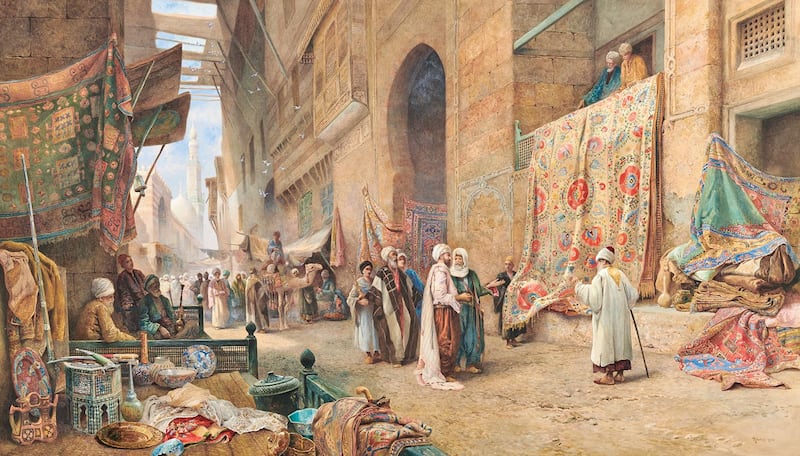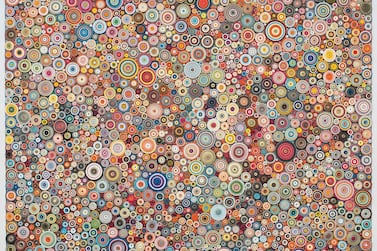“It’s a collection that we’ve admired and have been dreaming about for many years,” says Sotheby’s director, Claude Piening, about the famous Najd Collection of Orientalist art.
Now, Sotheby's long admiration has paid off: next month, the auction house will exhibit the entire trove in its London showroom and sell 40 out of the collection's 155 works. Assembled in the 1970s and 1980s, the Najd Collection has some of the best exemplars of Orientalist painting. Half of the works are by three of the most important artists in the movement: Jean-Leon Gerome, Ludwig Deutsch and Rudolf Ernst, who were all based in France at the height of the 19th century's celebration of the Middle East.
Who were the Orientalist artists?
The Orientalist artists, almost all of them European men, pictured the Arabian region as one of luxury and exquisite artistry. In a watercolour by Charles Robertson, a group of turbaned men examine a richly patterned red and gold carpet in a Cairene market.
Gerome painted many images of Muslims at prayer – in one, a man in a sumptuous yellow robe holds his hands towards Makkah while others kneel behind him in the high-ceilinged mosque. Other paintings depict daily scenes inside the extraordinary interiors of Arabian palaces. Austrian-born painter Deutsch painted a series of characteristic figures of the Ottoman world. In one, a palace guard stands with scent wafting in front of him.
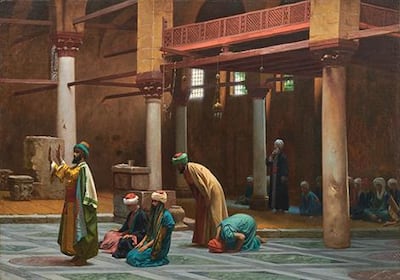
In a work by the American Frederick Arthur Bridgman, a messenger accompanied by a gazelle hands a note to a dignitary who reclines within a nook decorated with intricate floral motifs. These are impressions of Arabia made by outsiders wowed by its charms. And that is the important thing about Orientalism: it's a controversial genre, seen by many as an extension of colonialist thinking. But in spite of postcolonial critiques, it's become favoured by those it supposedly caricatures.
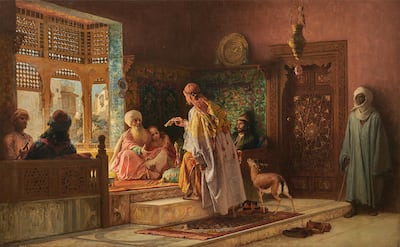
Changes in perception
Today, "75 per cent of all Orientalist paintings that we sell are to collectors in the wider Islamic world, both private collectors and museums," says Piening. The Najd Collection has played a crucial role in the movement's evolving reception. It was put together with London art dealer Brian MacDermot, who was instrumental in bringing Orientalist work back into market circulation. And, though the collector has remained anonymous, it was one of the first Orientalist collections assembled by someone from the region ("Najd" is the central area of Saudi Arabia, though the collector's exact nationality has not been confirmed). It is also one of the first collections of Orientalist work itself, assembled in the 1970s and 1980s, when no one else was interested.
"It would be nigh on impossible to put together a collection like this today," says Piening. "It was pioneering." By the time the Najd collector stopped acquiring work in the 1990s, Orientalist art was becoming en vogue among Arab collectors, especially in the Gulf. Orientalist works were some of the first sales that Christie's and Sotheby's held in Dubai in the late 2000s. Sheikh Dr Sultan bin Muhammad Al Qasimi, Ruler of Sharjah, has a major collection he put on view at the Sharjah Art Museum in 2013 in a much-lauded exhibition.
New fine-art museums in the Middle East and wider Islamic world have also fuelled demand for Orientalist work. One of Louvre Abu Dhabi's most famous works is an Orientalist painting: Osman Hamdi Bey's Young Emir Studying, showing a young student lying on his front in an Ottoman setting, reading a book. The image was used on advertising billboards and in marketing in the months before the museum's opening, and remains a central work in the museum's collection (Hamdi Bey was a Turkish artist trained in France, and is the only major non-Western Orientalist painter).
Other institutions include Doha's Orientalist Museum – established in 2005 and the only one devoted purely to the genre – and the Islamic Arts Museum Malaysia (IAMM). Sotheby's sale of the Najd Collection marks, in a sense, the end of one era of private collecting, and as it does so, a new one begins, led by museums in the Middle East and wider Islamic world.
In October, as the Sotheby's sale goes on view, the British Museum will stage an exhibition of Orientalist work with significant loans from IAMM. It is titled Inspired by the East: How the Islamic World Influenced Western Art. IAMM's director, Syed Mohamed Albukhary, is also the brother of Syed Mokhtar Albukhary, who recently sponsored the celebrated renovation of the British Museum's Islamic arts galleries.
Julia Tugwell, a co-curator of the British Museum show, says the curators were inspired by how the reception of the paintings has shifted in recent years. "Many of the collectors actually come from the Middle East and North Africa and see these artworks as important visual records and interpretations of their heritage," she says. "So it feels particularly timely to be exploring the roots of the Orientalist art movement in the coming exhibition, especially as we'll do it through a full spectrum of artistic mediums."
What did Orientalist art tell us about the world it depicted?
Piening, too, says that Orientalism provides a pictorial history of the region that is otherwise lacking: "Until relatively recently, visual artists from the region were not painting in a figurative style. Islamic art was much more object-based, geometry-based, craft-based. Therefore, no visual record was being made by the people from the country.
"The Orientalist painters wouldn't have realised this at the time, but it fills a documentary gap. In the case of the Najd Collection, with 155 pictures, you have a very broad-sweep survey of how the Islamic world might have looked 100 years ago, spanning from Morocco to Istanbul, or Constantinople to Cairo."
Many of the subjects depicted, such as the Umayyad Mosque in Damascus or the souqs of Jaffa, have been victims of conflicts in the Middle East over the last century, making these visual records that much more poignant. But it is important to take these assertions of Orientalism as document with a grain of salt.
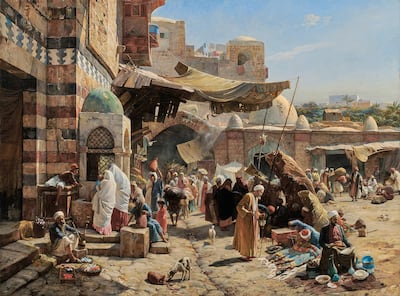
Inaccuracies abound: styles of clothing associated with the Ottoman region appear in architectural settings of the Maghreb, for example. And, Piening says, there were plenty of what he calls "armchair Orientalists": paintings "by artists who never travelled to the region, who never experienced the region, and who simply relied on second-hand accounts to conjure up exorcising and frankly unrealistic impressions". He says that none of these armchair Orientalists appear in the Najd Collection.
This criticism of the genre is persuasive. Though gorgeously painted and technically accomplished, Orientalist painting also exoticises the Arab world, presenting it as a realm of veiled harems, idle beys and peasant girls carrying water jugs through the rocky landscape. In 1978, just as the collector behind Najd was acquiring the genre, the Palestinian scholar Edward Said published his influential study of Orientalism as the literary and artistic continuation of imperialism – and chose a work by Gerome for the cover.
But just as the work has been rehabilitated by the art market, academic study of the genre has also moved away from Said's excoriation. The genre's complexities have made for fertile terrain. The French scholar Mercedes Volait has used the market's recuperation to examine how private collecting can affect public taste. Other art historians, such as Salwa Mikdadi at NYUAD, have looked at what might be called reverse Orientalism, such as the adaptation of Orientalist tropes by Egyptian artists themselves in the early 1900s, when Cairo became home to Italian artists fleeing the First Wold War. For other scholars, such as John MacKenzie, the lure of the East was not only to do with imperialism, but also a taste for the handmade during a time of Western industrialisation. For both London exhibitions, in any case, the story behind the works is as compelling as the paintings: the subjects who were previously observed and depicted are now the owners of the works.
The entire Najd Collection will be on view at the Sotheby’s showroom in London from Friday, October 11 to Tuesday, October 15. Selected highlights will be in Dubai, on view at the Sotheby’s exhibition room in DIFC, beforehand on Sunday, October 6 to Monday, October 7. The British Museum’s Inspired By The East: How the Islamic World Influenced Western Art is on view in London from Thursday, October 10 to Sunday, January 26, 2020
